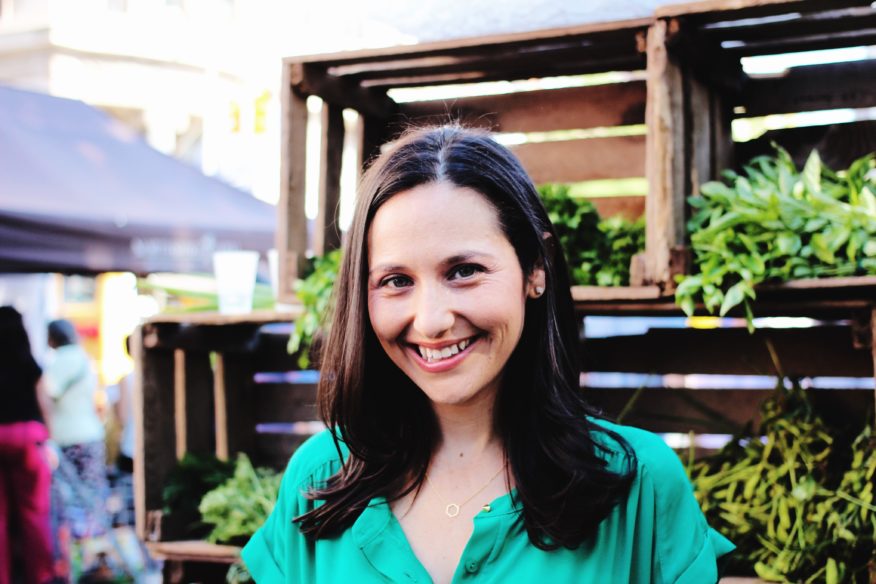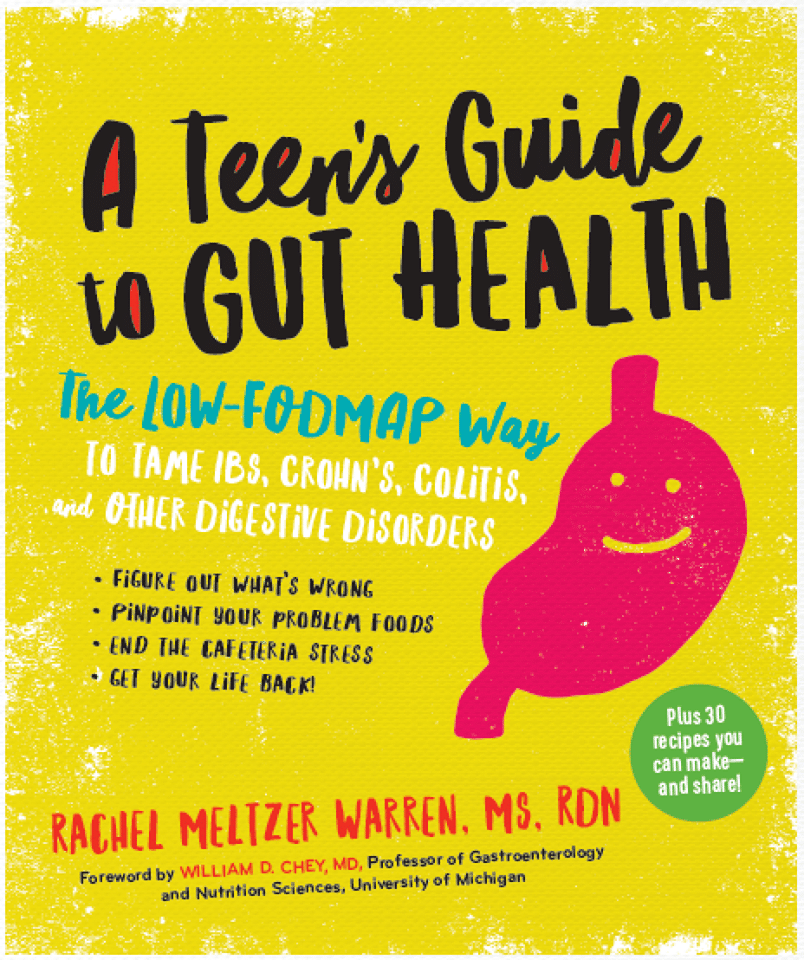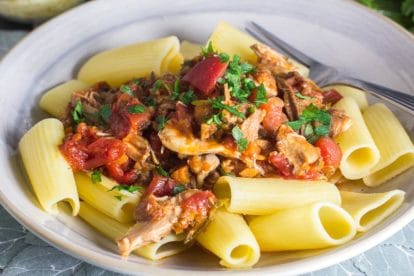Note: This post may include affiliate links. Please see our complete disclosure here.
If You Are Under 25 Years Old, Rachel’s Got Your Back…
Rachel Meltzer Warren’s book A Teen’s Guide to Gut Health recently landed on our desks and we have been reading it cover to cover. Rachel is a member of the FODMAPeveryday Success Team and while we always like to support our own we can safely say quite objectively that we are thrilled to bring you this interview because the topic – teens, young adults and gut health – is a huge area that deserves its own focus.
While people of all ages can unfortunately suffer with IBS the good news is that the low-FODMAP diet can help alleviate symptoms regardless of one’s age. The issue at hand is that different age groups have different psychological responses, logistical needs and ways of learning, as well as varying nutritional demands.
Rachel tackles this head on in her book and she sat down with us to go over some important highlights.
First of all Rachel, congratulations on the publication of your second book. In the first, The Smart Girl’s Guide to Going Vegetarian, you took on a similar need. In that case you wanted to support young women navigating a switch to a vegetarian diet by helping them learn to make smart dietary choices within their desired scope of eating.
Why did you decide to take on gut health with a focus on the low-FODMAP diet at this time?
Thank you, Dédé! In my work as a registered dietitian nutritionist (RDN), I see clients of all different ages, from kids through adults. But I’ve always felt a strong pull toward the pre-teen through young adult population. I think it goes back to my own personal story; I first became interested in nutrition when I was a middle schooler who decided to go vegetarian—my journey was very much the inspiration for the first book!
Me too! I went veggie at about age 15 (for about 10 years) and back then all we had was Frances Moore Lappé Diet for a Small Planet. My Mom was so nervous that it would negatively affect my growth. She sent me to the pediatrician, who gave me the thumbs up!
To my Mom’s credit, she worked very hard at making me vegetarian food. She came up with a soybean loaf with grated carrots – of course neither of us knew it was high in FODMAPs.
Teens are at a really crucial stage when it comes to their health; their experiences have a huge impact on how they approach their wellbeing for life. Much of my work is dedicated to helping empower young people to take charge of their health now so that living a vibrant, happy adult life comes naturally.
I decided to write A Teen’s Guide to Gut Health after working with a number of young people with gut issues. I realized that IBS is just as prevalent in teens as it is in adults—around 15% of the population! I saw the need for a manual that could help demystify the process of getting diagnosed and managing the challenges come along with having a gut disorder.
I also wanted to help a teen know he or she is not alone. Around the same time, I began to learn about the low FODMAP diet, and had clients who were finding success on it. When I realized that there was a tool that could help young people suffering with IBS to get their lives back without embarrassing treatments or potentially detrimental medications, I became passionate about creating a resource that would make the low FODMAPs diet manageable and accessible for teens.
For those of us dealing with IBS we know all too well how daunting a significant dietary change can be. What are the top 3 challenges for teens and young adults in particular?
Dietary change is hard, especially if you’re a teenager! The first challenge is that teens are often not the ones in charge of buying the food at home. So mom and dad—or whoever it is that does the shopping—need to be on board with whatever the dietary change is.
And this is different for teens who are embarking on a low FODMAP plan than it is for a teen who is giving up meat, because in order to get your family on board you have to be up front about why you want to follow this diet (this is a good time to point out that you should never try a low FODMAPs diet without getting your doctor’s approval first; he or she will want to rule out some other more serious conditions as well—being open with parents about why you want to try a dietary change like the low FODMAPs plan is, of course, the first step in getting that medical care).
So I’d say that talking openly about digestive symptoms is a second challenge for teens with IBS. This can completely differ based on the culture of your family—some families just love talking about poop and farts—so much that they can go too far for a teen who is having some issues in that department!
Other families wouldn’t even think of discussing the subject.
This is such a great point and it never occurred to me. Our family was very open about stuff like that; it would be so much harder if it weren’t typical, easy conversation.
My book outlines strategies for talking to either type of parent about your gut symptoms. The third challenge I see for teens and young adults who are making a big dietary change is how to manage social situations.
How do you say “no thanks” when your soccer team is having a pizza party without seeming rude—or having to explain the reason why in more detail than you’d like?
There’s no wrong or right way to handle these situations; it’s really all about the comfort level of the individual. But my hope is that the book gives my readers strategies that will help them navigate these challenges, and feel good about the outcomes.
Often, having one or two friends you can really confide in key. So is planning ahead and always being prepared with low-FODMAP approved snacks!
How can parents best support their teens who are following the low-FODMAP diet? Do you recommend that parents take part in RDN meetings with the teen? I imagine it works best if everyone is on the same page and supporting the process, but what is the best way for this to work?
Parents are naturally part of their teen’s “care team”— being involved in meetings with a registered dietitian nutritionist is absolutely part of that, especially for a child who still lives at home. A college student or young adult may not need as much parental support. But a parent whose child lives at home needs to be engaged in the process.
Parents can also look for ways to involve their child in the acquisition and preparation of food. So things like taking your teen grocery shopping or having him do some online grocery shopping; asking for her help making dinner, etc. serves two purposes:
1. It helps the teen enjoy the food he is eating, so he will be more likely to succeed in following the plan.
2. It gives her tools that will be important for eating well on her own in the future, and for life.
Give us some tips for teens sticking with the diet during the school day and also for when they are socializing with friends. Just thinking about how complex this must be makes me want to give your book to teachers, school administrators and non-FODMAP students, too!
Planning ahead is key. When it comes to the first phase of the low FODMAPs diet, so many common ingredients are off limits. I recommend bringing your own food as much as possible. But when that’s not realistic—or once foods have been reintroduced, and the diet is a bit more liberal—do your homework!
So asking questions in the cafeteria about how foods are prepared, reading labels, checking out restaurant websites (chain restaurants will often tell you specific ingredients in their foods; how cool is that?!) can all make your life a lot easier in the long run.
As for finding support; everyone is different—some teens want to shout it from the rooftops, others are more private. The teens I surveyed for the book seemed happiest when they found one or two friends or adults at school to confide in.
I really like your idea of a “care team” and these 1 or 2 best friends, with whom you can share details and issues, can be part of that. I love how you teach teens in the book to read labels and navigate school salad bars. It really is about empowerment. What have you found to be some “aha” moments for teens that might help others reading this?
When it comes to low FODMAPs, it’s not always obvious. I think that’s the biggest thing for people of any age to remember. So getting the low FODMAP app from Monash University is key to following the plan.
You are not expected to know it all offhand! I think another key “aha” is that gluten free does not necessarily equal low FODMAP. Many gluten free products are suitable for a low FODMAP diet, but loads are not—I’m thinking of a brand of gluten-free cookies that were great for a client with Celiac, but wrecked the belly of an IBS client, probably because they were made with garbanzo bean flour.
So read ingredient lists, and be your own advocate.
Oh don’t get me started! I was gluten free for 25 years and it turns out that is was mainly the FODMAPs that I was reacting to. Who knew? Certainly not my old GI doc! Now I can enjoy a slice of sourdough now and then.
Talk to us a bit about the transition from teens to young adult. As a teen living at home, you often don’t have to worry about grocery shopping, meal planning, cooking, etc. Then, as you leave for college or move out of the home you are all of a sudden in charge – which can be a good thing or a scary complicated thing!
Give us some low-FODMAP organizational tips for kids this age.
It’s scary and exciting, all at the same time! Learning how to navigate the dining hall or shop for your self can be a challenge to any college student; add in some dietary restrictions and it gets far more complicated. But I assure you, it’s not as daunting as it may seem.
One thing I recommend in the book is that if you do eat in the dining halls, it may be better off to wait until you’re home for winter or summer break to do the low FODMAP elimination. That way you’ll have more control over what’s going into your food.
But if you really cannot wait (or don’t plan on going home any time soon), you can make it work. Again, do your homework. Find a food service director or registered dietitian who works with your campus food service who can help you locate ingredient lists for the foods that are being served.
With a little planning (and a little “caf hacking”—liberating ingredients from here and there and making your own creative and delicious meal), you can know what foods are safe, and have a few go-to meals.
If you do your own shopping and cooking, there’s more work for you to do—but you are in control, so it’s actually a lot easier to succeed!
I love that term “caf-hacking”! It is hard for non-FODMAPers to understand but we do not have to worry so much about cross contamination. For instance, we can pick all the onions off of a salad or take a hamburger off of its bun!
You have some simple and tasty recipes in the book; I particularly love the super-quick Mini Polenta Pizzas using logs of prepared polenta. Do you have any easy to make recipes that didn’t make it into the book that you could share here?
I’m a little embarrassed to say this since I love all of the recipes in both of my books. But my favorite meals are recipe-less ones! I’m a big fan of bowl meals, lately—all you need is a little creativity. So I’ll start with a green, like baby spinach or kale. Top it with a low FODMAP grain like quinoa or brown rice, and let the heat wilt the green slightly.
And then I’ll add in whatever I’ve got on hand that’s low FODMAP, so roasted veggies or chopped raw veggies; tofu or a fried egg (I don’t eat meat, but chicken or shrimp could work well here). And then top it with a sauce or just some olive oil and lemon juice or a little balsamic vinegar.
Oh, and a sprinkle of nuts or seeds, for some crunch.
This is so funny! Even before I was FODMAPping I was a big fan of what we call The Big Salad in my house. It is exactly as you describe – the combination of hot and cold, incorporating leftovers, varying textures, etc. I love it!
Rachel, thank you so much for your time. We wish you luck with your new book – and your other new addition Ezra, born this April.
To learn more about Rachel and her services, books and to connect with her directly visit her Bio Page here!
Thank you!
Read Rachel’s articles:
Watch our Facebook Live Chat with Rachel on Tips & Techniques for Young Adults Living on Their Own with IBS










I can’t say enough how excited I am for this book. My daughter is only 7, and after 6 years and 10 months of pestering her doctors, she is finally on a Low Fodmap diet successfully. She knows all to well the school, social and extended family challenges (saying no and feeling left out) associated with her diet. It is her number one topic of frustration many nights before bed. I even have a nephew at 15 who finally went dairy free after years of complaining to his parents, so this book can be a blessing of support to unrecognized pediatric sufferers. I can now use this book for his parents who are still in diet denial. Even pediatric doctors are in denial despite family history. Maybe this can be her next book…
Leslie, thank you for writing and we will make sure that Rachel sees this message. We empathize with what you are dealing with. Your idea is interesting and we might propose it as an article for Rachel. Thank you so much for taking the time to write and we wish you luck on your FODMAP journey and hope we can continue to be of help.
Hi Leslie!! Thank you so much for your comment. I’m always disappointed when I hear about doctors who aren’t addressing diet with their patients. Well done advocating for your daughter! I hope the book is helpful to both of you!!!